We grow our own food in a suburban village in the North East of England. Follow us as we keep up the battle to be self-sufficient.
Tuesday 31 July 2012
Treating the hens for worms
Once a month I treat the hens for worms. We give them herbal pellets mixed into their mash. The brand we use is called Verm X. The hens are given the pellets for three days in a row - 2.5g for each hen. I filmed this video a couple of weeks ago.
Monday 30 July 2012
Egg production going back up
My hens seem to be recovering from their first moult and as a result, the number of eggs they produce has gone back up. There were 7 laid yesterday, 5 of which came from the older hens - ie those we purchased last year and in January. One of those hens is yet to start laying again. The other two come from the white leghorn and the pied suffolk we got at the start of July. The White leghorn started laying through the week and the suffolk laid her first yesterday. We are of course awaiting the first egg from the nine new hens we got last week but it will probably not be for at least a couple of weeks yet before we get anything from them.
Sunday 29 July 2012
One of these piglets may soon be ours
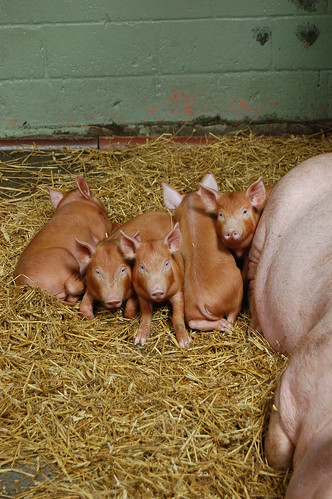
One of these piglets may soon be ours! Don't worry, we aren't going to put a pigsty in the garden or allotment. Instead, we are going to buy a pig from Bill Quay Community Farm just before it goes to slaughter and then pay for the slaughter costs. It's not quite self-sufficiency as we know it but it is about food miles. The pigs will go free range for a few weeks before they are slaughtered and I am going to take up a few buckets of acorns to be fed to them - though I have to confess I forgot to mention that to the staff running the farm when I was up there today so the final decision on fattening up the piggies on this natural food will rest with them.
Before getting the pig, we need to rearrange our storage. That means getting another freezer, learning how to smoke meat and how to make sausages. This is going to be a really big project for the autumn and I'm rather looking forward to it.
Checking the bee hives
We have had a bit of a bee day today (though we also found time to go to the Gateshead Summer Flower Show). We started at Bill Quay Community Farm where we checked the three hives - we are volunteer beekeepers at the farm. All three looked in good order. One hive may possibly have a small honey surplus that could be harvested later in the summer.
After the flower show we went to our Whickham apiary where we have three hives, all created from swarms in June. The main concern was whether or not they had fertile queens. The bad spring weather may have deterred virgin queens from leaving the hives to be mated. As we walked through the garden to the hives we could see a great deal of activity, always a good sign. And each hive had bees taking in lots of pollen, usually a sign that there are lots of bee larvae needing to be fed and therefore a queen is laying. When we opened each hive, we found a strong colony in each and lots of brood. The problem was that they had filled the supers with comb that contained brood. The supers had been added so that we could put fondant into the hives to feed the bees. Removing this is not going to be easy as it is attached to the cover board. We will call on a friend for advice. John has kept bees for decades and his thoughts on the matter are needed.
We then headed up to our first apiary and checked the four hives there. The first could possibly give us a small honey crop in a few weeks' time. The second has the same problem as the hives in the other apiary - comb full of brood attached to the cover board. The third had brood (I had previously had concerns that the hive was possibly queenless but the presence of brood shows the queen is still alive and active. Given this hive swarmed a number of times last month, it probably contains a very young queen that has only recently been mated.) The final hive is a merger of a small swarm and a hive that had become queenless. We found brood in it so it seems as though it is operating as it should though I feel we need to keep an eye on it.)
So, all in all, I was pleased with what we found after the disappointment of earlier this month when we opened the hives and found no honey and were left wondering whether many of the hives were viable. At best we will only get a small honey crop but hopefully the hives will be in a strong position next year to go into serious honey production.
After the flower show we went to our Whickham apiary where we have three hives, all created from swarms in June. The main concern was whether or not they had fertile queens. The bad spring weather may have deterred virgin queens from leaving the hives to be mated. As we walked through the garden to the hives we could see a great deal of activity, always a good sign. And each hive had bees taking in lots of pollen, usually a sign that there are lots of bee larvae needing to be fed and therefore a queen is laying. When we opened each hive, we found a strong colony in each and lots of brood. The problem was that they had filled the supers with comb that contained brood. The supers had been added so that we could put fondant into the hives to feed the bees. Removing this is not going to be easy as it is attached to the cover board. We will call on a friend for advice. John has kept bees for decades and his thoughts on the matter are needed.
We then headed up to our first apiary and checked the four hives there. The first could possibly give us a small honey crop in a few weeks' time. The second has the same problem as the hives in the other apiary - comb full of brood attached to the cover board. The third had brood (I had previously had concerns that the hive was possibly queenless but the presence of brood shows the queen is still alive and active. Given this hive swarmed a number of times last month, it probably contains a very young queen that has only recently been mated.) The final hive is a merger of a small swarm and a hive that had become queenless. We found brood in it so it seems as though it is operating as it should though I feel we need to keep an eye on it.)
So, all in all, I was pleased with what we found after the disappointment of earlier this month when we opened the hives and found no honey and were left wondering whether many of the hives were viable. At best we will only get a small honey crop but hopefully the hives will be in a strong position next year to go into serious honey production.
Speaking to the U3A
On Friday I was the guest speaker at the Whickham U3A (University of the 3rd Age - a group for senior citizens) where I gave a presentation about self-sufficiency and why I gave up my job to grow my own food. The presentation went well. The issue of most interest was - how to capture a swarm of bees! A close second was food waste and why throwing away food is, in my opinion (shared by the 40 ladies in the audience) a terrible sin.
I ran through the history of how we took over a derelict piece of land and have turned it into a productive allotment. There was also some interest in my wild food foraging activities. It seems the ladies have not had enough of me. Some of them suggested I come back to their September meeting, and bring my jams with me!
I ran through the history of how we took over a derelict piece of land and have turned it into a productive allotment. There was also some interest in my wild food foraging activities. It seems the ladies have not had enough of me. Some of them suggested I come back to their September meeting, and bring my jams with me!
Tuesday 24 July 2012
Elderflower drop scones
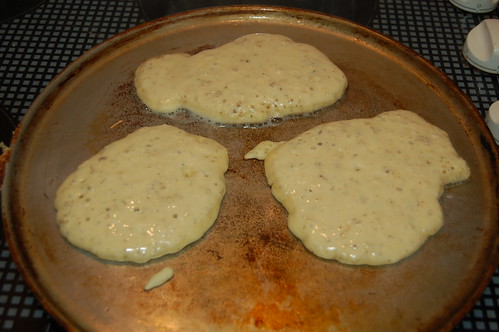
The rotten weather (which now seems to be improving) seems to have delayed the elderflower this year. Normally I am rushing to pick the flowers to make champagne and drop scones before they disappear at the end of June. We are near to the end of July and there is still some elderflower around.
Elderflower drop scones are lovely. Slap on a bit of gooseberry jam and they are almost unbeatable! I filmed a short video about how to make them which is not edited yet but here is the recipe I used:
125g self-raising flower
2 tsp sugar
150 ml milk
large handful of elderflower stripped from the stalks
1 beaten egg
Mix together the flour, sugar and elderflower. Make a well in the centre of the dry mix and add the egg and some of the milk. Stir and add remaining milk until you have a batter free of any lumps of flour. If it is very thick, add a touch more milk.
Pour a tablespoon of batter onto an oiled pan on a moderate heat. (Make it too hot and you will incinerate the outside but not cook the inside.) Cook for about a minute and then flip over to cook the other side for about a minute.

New hens
On Sunday the next stage in our hen keeping venture was reached. We built our second henhouse, extended the chicken run and went down to Durham Hens to buy 9 new hens. They are settling in well. We got 9 because that was the capacity of the henhouse.
We got 4 columbines (they lay olive green eggs), 2 ginger nut rangers, 2 ambers and a speckeldy.
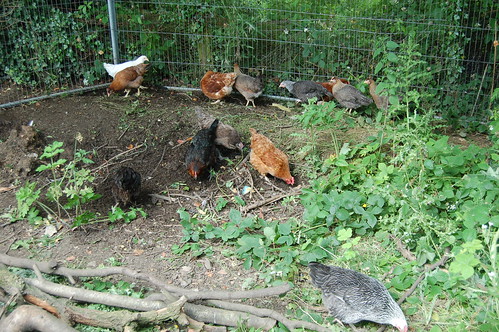
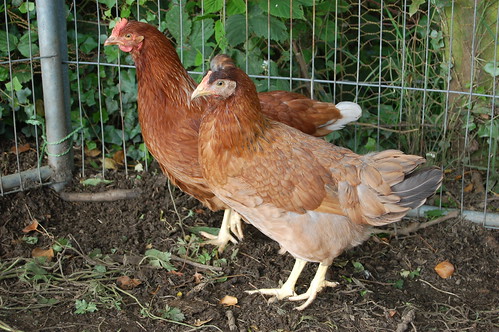
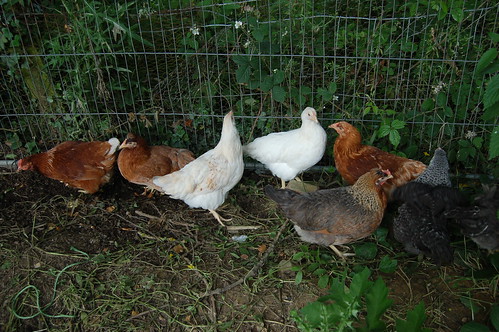


This is the henhouse:


We got 4 columbines (they lay olive green eggs), 2 ginger nut rangers, 2 ambers and a speckeldy.





This is the henhouse:


Thursday 19 July 2012
Egg yields are down
We are still relatively new at keeping chickens (we got our first in September last year) so we are still learning about keeping them. Recently we have gone from an egg mountain to a big drop in production. We are getting only 2 or 3 a day where previously we were getting 5 or 6. We thought the hens were possibly laying in a hidden location on the allotment as they did recently, but a thorough search turned up nothing. Yesterday I kept the hens in the chicken run until the mid afternoon to see if they were actually laying or not. Again, we ended up with just 3 eggs. They also disliked being kept in the chicken run and complained loudly until I let them out in the late afternoon.
We speculated that perhaps some of them were not laying because they were getting a bit fat. Yet they have plenty of exercise and though they are a good weight, obesity does not seem to be affecting them. Today we think we found the solution. The hen house contained a large number of feathers when I opened it this morning. And this afternoon, the hens were sitting near the greenhouse and were surrounded by feathers. It appears some are moulting and this can temporarily stop egg production. I'm not sure how long it will be before moulting is over and they start laying again. The moult is affecting only a couple of birds but we could do with them getting back into egg production as soon as possible.
We speculated that perhaps some of them were not laying because they were getting a bit fat. Yet they have plenty of exercise and though they are a good weight, obesity does not seem to be affecting them. Today we think we found the solution. The hen house contained a large number of feathers when I opened it this morning. And this afternoon, the hens were sitting near the greenhouse and were surrounded by feathers. It appears some are moulting and this can temporarily stop egg production. I'm not sure how long it will be before moulting is over and they start laying again. The moult is affecting only a couple of birds but we could do with them getting back into egg production as soon as possible.
Thursday 12 July 2012
Mud, mud, glorious mud!

Three months of heavy rain and we have quite a bit of mud on the allotment. I took these photos yesterday. The above picture was taken from the gate coming into the allotment. I just managed to get the mini polytunnel set up (below) when the skies opened.

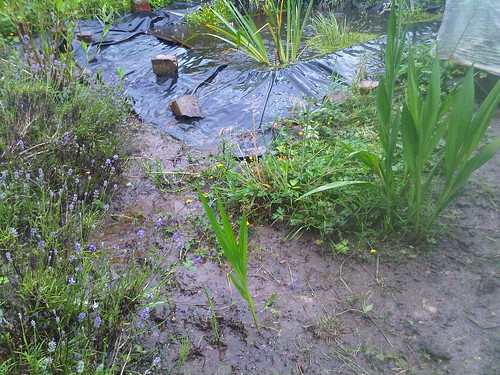
The pond was overflowing yesterday (see above) and you can see how sodden the ground is.
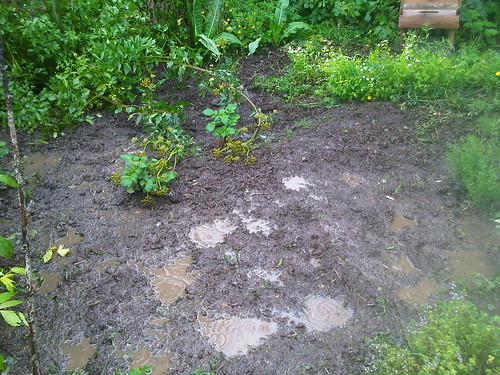
This is bed 5. I planted it out with turnip and swede seeds 6 weeks ago but they came to nothing, possibly because of the weather. You can see how waterlogged the ground is.
Tuesday 10 July 2012
How to make pickled eggs
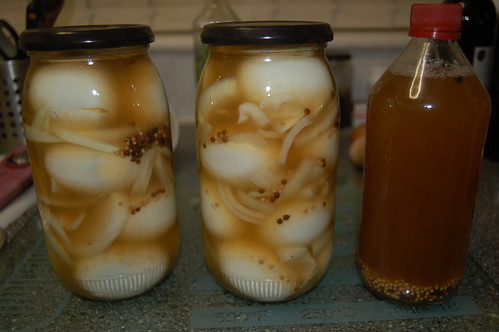
The last time I made pickled eggs was about 25 years ago but our recent egg mountain encouraged me to make them again.
Hard boil your eggs and then shell them. The vinegar can either be purchased as a pickling vinegar ready to use or, as I did, get a bottle of white vinegar and add some mustard seeds, coriander seeds, some cloves and a cinnamon stick. Bring the vinegar and spices/seeds to the boil and then simmer gently for about 10-15 minutes.
Allow to cool. You can strain the vinegar if you wish but I didn't. It looks better with the seeds in and the flavour of the seeds continues to infuse into the vinegar. (See photo above.)
Thinly slice some onions. Put the eggs and onions together into a pickling jar and then pour in the vinegar. Seal the jar and leave to stand for about 10 days before starting to use.
My confession is that I didn't get to try any of the eggs in the photo above. I ended up swapping both jars for other people's produce! I will need to pickle some more.
Sunday 8 July 2012
Pea sticks - 2nd attempt
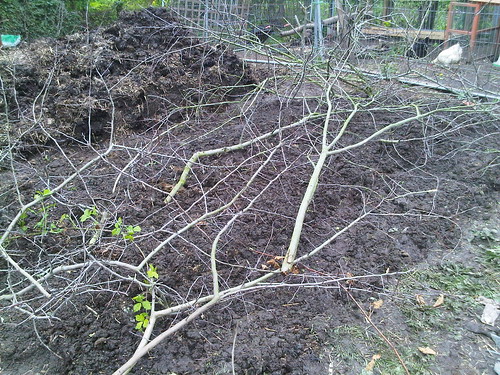
I took the above photo early last month. The branches were placed over the bed where pea seeds had been planted. The aim was to keep the birds and the hens off the seeds and then to give the peas something against which to grow. When I saw one of my hens casually walk across the bed through the sticks, I knew it was a failure. This was confirmed when only a handful of peas actually grew. My solution was to be considerably more thorough in setting up the defences.
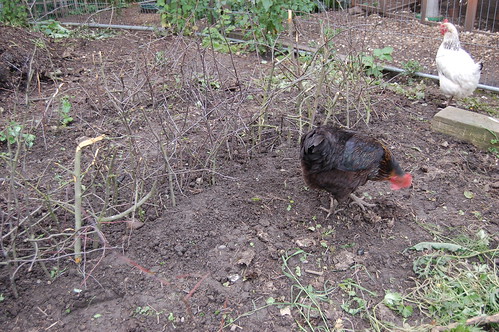
The above photo shows the new approach. I used hawthorn and ash sticks to create a barrier on either side of each row of peas. At the moment it seems to be working. As you can see, my hens walk over the bed but they can't dig up the pea seeds.
Friday 6 July 2012
Gooseberry and elderflower jam
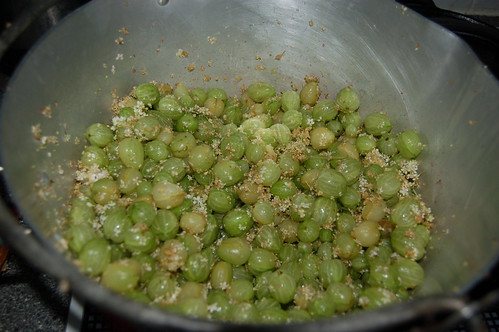
Making this recipe normally means that summer has arrived, though given the awful wet weather we have endured for the past 2 months, "summer" is hardly the description I swould use. Nevertheless, our gooseberry crop has now been picked and I have used it to make gooseberry and elderflower jam.
To make it, weigh your gooseberries and put them in your jam pan. Then add a good handful of edlerflowers - strip them from their stalks first.
Apply heat. Bring to the boil, stirring regularly. The fruit should quickly begin turning to a pulp. Once it has started boiling, turn heat down to allow it to simmer until all the fruit has pulped.
Then add sugar - the same weigh of sugar as you had of gooseberries. Stir in the sugar and bring back to the boil, keeping it on a rolling boil until it has reached setting point - ie when a skin forms on a small dollop of it on a saucer away from the cooker.
Then add to hot, sterilised jars.
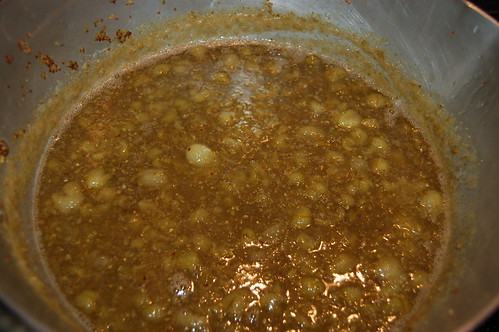
Thursday 5 July 2012
Our polluted oceans
The people who created the following graphic have asked me a couple of times if I would be interested in including it on my blog. I have looked through it and though it is not a reflection of the issues with which I deal on Self-Sufficient in Suburbia, it nevertheless coincides with my views and concerns about how we are treating our planet. So here it is:

Created by: MastersDegree.net
Fish and seafood is something I have reduced in my diet. There are a couple of reasons for this. Firstly, I am aiming to be self-sufficient so eating haddock ad king prawns doesn't exactly fit in with that. Secondly, I am concerned that we are overfishing our seas and oceans. Fish and sea food is therefore consumed by me as a reasonably rare treat.

Created by: MastersDegree.net
Fish and seafood is something I have reduced in my diet. There are a couple of reasons for this. Firstly, I am aiming to be self-sufficient so eating haddock ad king prawns doesn't exactly fit in with that. Secondly, I am concerned that we are overfishing our seas and oceans. Fish and sea food is therefore consumed by me as a reasonably rare treat.
Wednesday 4 July 2012
One of my hens has bumblefoot
Sleepy, one of my hens, recently suffered from bumblefoot. The pads of the feet swell up and become scabby and pussy. They need to be cleaned in warm water, iodine dabbed on and then magnesium sulphate paste rubbed in. The video shows how to do it.
Tuesday 3 July 2012
Hunting for the missing eggs
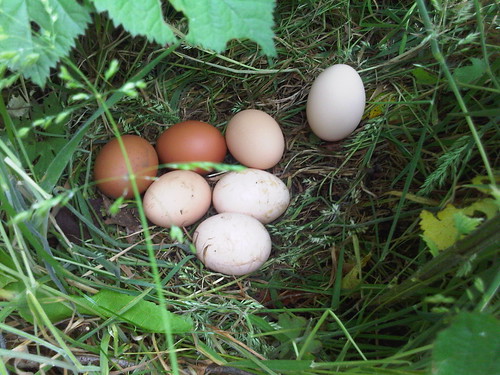
We had one egg from our hens yesterday, or so we believed. I was beginning to wonder if they were doing an impersonation of Britain's public sector unions by going on strike. Today, whilst working on the allotment, I was, as usual, mobbed by the hens whilst digging the ground. Snow White, our coral nick, was missing. I checked the hen house but she wasn't there. I walked around the raspberry bed where they often spend time, but couldn't see her there. Then I spotted her in some well hidden undergrowth, sitting down and about to lay. I left her to it.
A few minutes later she joined me on the bed I was digging so I headed over to where she had been laying, and found 7 eggs! It looked as though at least 3 of the hens had used the impromptu nest in the last couple of days. The eggs are now in the kitchen.
I have heard from other hen keepers that hens can sometimes find hidden alternative locations to lay. So if you let your hens out into the garden or allotment, do a thorough search if egg yields appear to go down.
Our new hens
On Saturday we got 2 more hens. Our existing hen house is therefore full to capacity with 8 birds. We bought another hen house as we are planning to expand our egg production. The new one, when built, will take 9 hens.
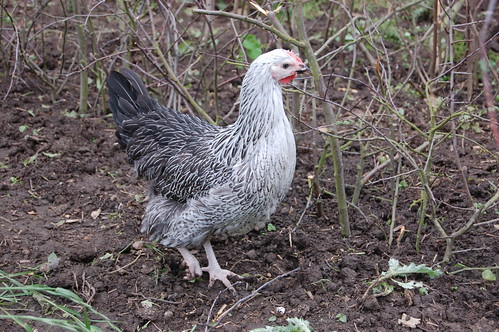
This is Pasty, our new pied suffolk.
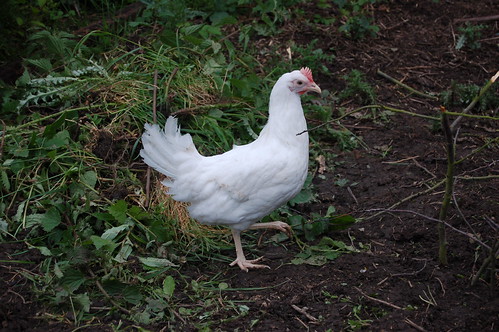
This is Fondant, our new white leghorn.
Both birds are a bit nervous and, as expected, are being bullied a bit by the others whilst the pecking order is re-established. However, both have started to explore the allotment and last night found their way back to the henhouse to roost, unaided by us.

This is Pasty, our new pied suffolk.

This is Fondant, our new white leghorn.
Both birds are a bit nervous and, as expected, are being bullied a bit by the others whilst the pecking order is re-established. However, both have started to explore the allotment and last night found their way back to the henhouse to roost, unaided by us.
How to deal with bee swarms
If you have read my recent posts you will know that our bees have been swarming like mad over the past month. In this video we show you how we captured the swarms and got them into new hives.
Sunday 1 July 2012
Hens, bees and weeds - the weekend round up
We have 2 new hens which we bought yesterday. One is a white leghorn and the other is a pied suffolk. The leghorn is a bit more nervous and smaller but the two spent yesterday afternoon, after being added to the chicken run, hiding away in the henhouse. Today they were a bit better. They both came out into the chicken run but stayed together whilst the other hens followed us around as we did some weeding. Alas, this evening, Snow White, the boss hen, chased them and they took shelter back in the henhouse. I doubt they will come out again before I lock them up at 10pm.
Meanwhile we have checked the new hives we have put into our additional apiary. This was another job we did yesterday. All 4 hives appear to have established themselves though the final one which was created on Tuesday has drawn out comb in completely the wrong part of the hive. We will consult with other beekeepers before we decide what to do.
We visited Bill Quay Community Farm in Gateshead yesterday to do some volunteer beekeeping. There are 3 hives at the farm, up one since we were last there. The new hive was created from a swarm that the farm managed to catch. Colleagues had been in last week to feed the new hive and when we checked it yesterday, there was no need to give them any more food. That is not the story with the hives at our Apiary 2. They all needed feeding - each one had drained a bucket of sugar syrup since they were created other than the new hive set up earlier this week. This time we gave them fondant.
I mentioned ealier that today we have been doing weeding. I have to admit we have been a bit negligent with weeding recently. The abnormal weather recently has been a real boon for the weeds so the job is doubly difficult. A few days ago I managed to weed half the fruitcage and part of bed 2 on our main allotment. Today we did a significant amount more and created a compost heap of monumental proportions. I also made a trip up to Dad's allotment at Marley Hill, the next village up from us. I had to weed half the main bed there so that I could put in 35 strawberry plants.
Finally, back to the main allotment to pick the gooseberries. We have planted a large number of small gooseberry bushes. In a couple of years' time they will be producing prodigious quantities of fruit but as they were all planted in last autumn, this year will see just a very modest quantity. I picked all I could find, which turned out to be more than I expected. They will be made into gooseberry and elderflower jam.
I will leave you with this photo taken of 3 of our hens getting in the way of the weeding:
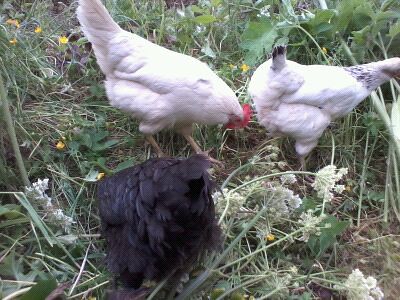
Meanwhile we have checked the new hives we have put into our additional apiary. This was another job we did yesterday. All 4 hives appear to have established themselves though the final one which was created on Tuesday has drawn out comb in completely the wrong part of the hive. We will consult with other beekeepers before we decide what to do.
We visited Bill Quay Community Farm in Gateshead yesterday to do some volunteer beekeeping. There are 3 hives at the farm, up one since we were last there. The new hive was created from a swarm that the farm managed to catch. Colleagues had been in last week to feed the new hive and when we checked it yesterday, there was no need to give them any more food. That is not the story with the hives at our Apiary 2. They all needed feeding - each one had drained a bucket of sugar syrup since they were created other than the new hive set up earlier this week. This time we gave them fondant.
I mentioned ealier that today we have been doing weeding. I have to admit we have been a bit negligent with weeding recently. The abnormal weather recently has been a real boon for the weeds so the job is doubly difficult. A few days ago I managed to weed half the fruitcage and part of bed 2 on our main allotment. Today we did a significant amount more and created a compost heap of monumental proportions. I also made a trip up to Dad's allotment at Marley Hill, the next village up from us. I had to weed half the main bed there so that I could put in 35 strawberry plants.
Finally, back to the main allotment to pick the gooseberries. We have planted a large number of small gooseberry bushes. In a couple of years' time they will be producing prodigious quantities of fruit but as they were all planted in last autumn, this year will see just a very modest quantity. I picked all I could find, which turned out to be more than I expected. They will be made into gooseberry and elderflower jam.
I will leave you with this photo taken of 3 of our hens getting in the way of the weeding:

Subscribe to:
Posts (Atom)